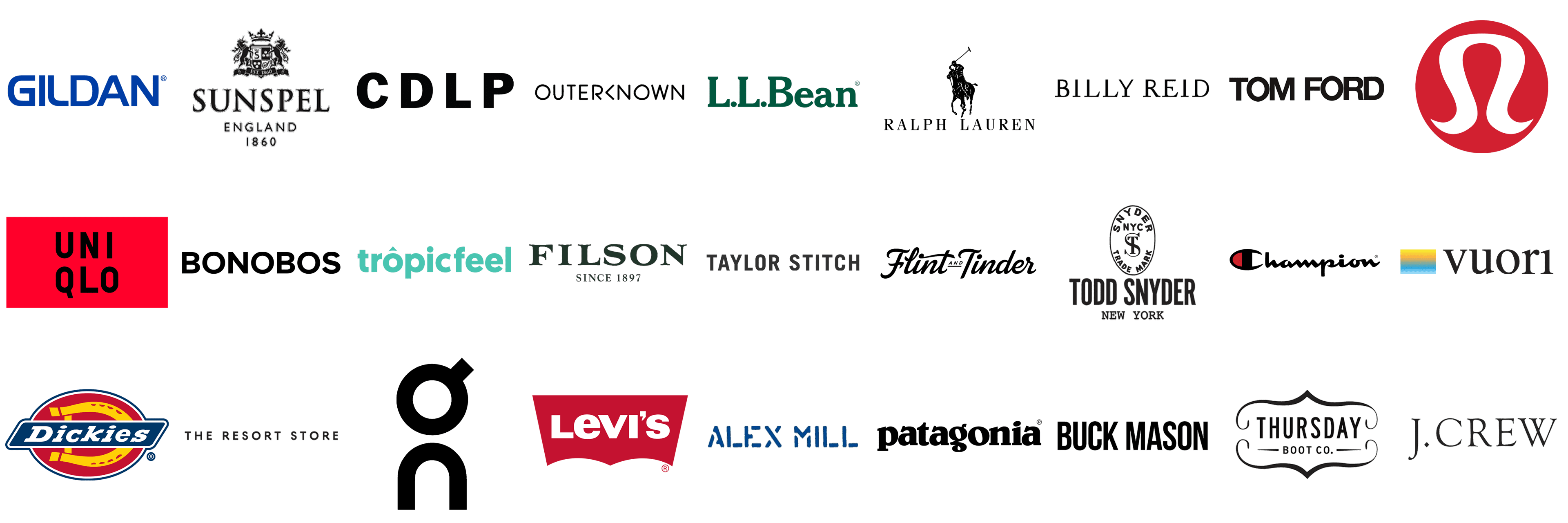Branded Clothing for Cold Climates: Which Fabrics Actually Work?
Branded Clothing for Cold Climates: Which Fabrics Actually Work?
Blog Article
The Relevance of Lasting Garments: Exactly How It Influences the Setting and Your Wardrobe
Sustainable clothing is progressively acknowledged for its essential function in lessening the environmental impact of the fast apparel industry. By concentrating on green products and ethical production techniques, it attends to pressing environmental concerns. This change not just profits the planet but additionally affects consumer options, causing a more thoughtful technique to closet administration. Comprehending these characteristics elevates important inquiries regarding fashion's future and individual duty in shaping it.
The Environmental Footprint of Quick Fashion

Advantages of Lasting Materials
Sustainable materials offer substantial advantages, especially via eco-friendly material options that lessen ecological harm. These materials additionally show toughness and durability, minimizing the need for frequent substitutes. Consequently, they add to a much more lasting style market and promote liable customer actions.
Eco-Friendly Fabric Selections
While the fashion business has actually long been related to rapid fads and ecological injury, the surge of environmentally friendly fabric choices provides a transformative chance. Sustainable materials such as natural cotton, hemp, and Tencel have gained appeal because of their reduced eco-friendly effect. These materials are frequently produced without damaging pesticides and need much less water, lowering their carbon impact - Branded Clothing. Furthermore, numerous eco-friendly textiles are biodegradable, adding to a round economic climate by reducing waste. Selecting sustainable materials not only sustains eco liable techniques yet also promotes healthier communities. As consumers come to be a lot more conscious of their purchasing power, the demand for environmentally friendly materials motivates brand names to innovate and embrace more sustainable manufacturing approaches, ultimately benefiting the planet and future generations
Toughness and Durability Advantages
Many consumers are increasingly recognizing the sturdiness and durability benefits of sustainable materials in their garments selections. Unlike traditional textiles, sustainable materials such as natural cotton, hemp, and recycled polyester are crafted to withstand wear and tear, causing garments that last longer. This lowered regularity of replacement not just conserves consumers cash over time but likewise reduces waste created by quick fashion. Additionally, sustainable garments commonly utilizes eco-friendly manufacturing techniques that enhance textile strength, adding to a reduction in the total carbon impact. By spending in long lasting clothes, consumers can cultivate a more sustainable closet while taking pleasure in top notch pieces that preserve their visual and functionality gradually. As a result, durability and durability stand as vital benefits of selecting sustainable materials.
Lowering Waste Via Sustainable Practices
Lowering waste in the apparel industry can be attained with ingenious practices such as upcycling and repurposing products. Additionally, adopting minimalist closet approaches urges customers to focus on quality over amount, ultimately decreasing clothes intake. With each other, these approaches add greatly to an extra sustainable clothing model.
Upcycling and Repurposing Materials
Upcycling and repurposing materials have actually become ingenious methods in the fashion sector, changing discarded fabrics right into beneficial new items. This method not just decreases waste yet additionally motivates imagination and individuality in apparel design. By taking old garments and materials, developers can produce unique pieces that mirror individual design while reducing the demand for new resources. Additionally, upcycling usually calls for much less power and water compared to conventional manufacturing procedures, substantially lowering the environmental footprint of fashion. As consumers end up being more mindful of sustainability, the popularity of upcycled clothing proceeds to climb, advertising a circular economy. Ultimately, these techniques add to a more lasting future, where fashion prioritizes ecological health over quick production and intake.

Minimalist Wardrobe Methods
As people progressively look for to lessen their environmental impact, taking on minimal closet strategies has gotten grip as an effective technique to lasting fashion. These techniques emphasize top quality over amount, motivating consumers to curate a smaller collection of versatile, long lasting clothing. By concentrating on classic pieces that can be combined and matched, individuals can minimize the frequency of acquisitions and eventually lower waste.Additionally, minimalism promotes conscious intake, advising consumers to review the moral and ecological effects of their options. This approach not just cultivates an extra sustainable way of life but likewise streamlines day-to-day decision-making pertaining to outfit. As people embrace minimal principles, they add to a style society that values sustainability and accountable consumerism, ultimately leading to a more eco-conscious culture.
The Function of Ethical Labor in Lasting Style
While lots of customers are progressively conscious of the ecological consequences of their clothing selections, the importance of moral labor practices in sustainable fashion can not be forgotten. Honest labor incorporates reasonable incomes, risk-free working conditions, and respect for workers' rights, developing the backbone of responsible style manufacturing. Brand names that prioritize ethical labor not only boost neighborhoods but likewise set a standard for accountability in the industry.Moreover, the combination of moral techniques cultivates transparency, making it possible for consumers to make informed selections regarding their acquisitions. This practice contrasts greatly with quick style's exploitative labor view it models, which usually prioritize earnings over individuals. By supporting companies devoted to moral labor, customers add to a system that values human dignity alongside environmental sustainability. Consequently, ethical labor is not just an add-on; it is crucial to the more comprehensive goal of lasting style, making sure that the mission for eco-friendliness does not come with the expenditure of human rights.
The Impact of Lasting Garments on Carbon Emissions
Lasting garments has the possible to considerably decrease carbon exhausts associated with the apparel industry. Conventional garment manufacturing adds significantly to greenhouse gas exhausts, mostly as a result of energy-intensive manufacturing procedures and making use of non-renewable sources. On the other hand, sustainable style focuses on environmentally friendly materials, such as natural cotton or recycled fibers, which commonly need less energy to produce.Moreover, lasting brand names have a tendency to adopt much more efficient production techniques, minimizing waste and reducing total emissions. By prioritizing sturdiness and timeless layout, lasting clothing motivates customers to get much less frequently, additional minimizing the carbon footprint related to overconsumption.Additionally, several sustainable brands are committed to openness in their supply chains, making it possible for consumers to make informed selections that align with their values. Ultimately, moving towards lasting apparel can lead to a considerable decrease in carbon emissions, adding to a much healthier planet and a much more sustainable future for the garment industry.
Supporting Neighborhood Economic Situations With Sustainable Options
The change toward sustainable apparel not just addresses environmental problems however additionally considerably advantages local economies. By choosing sustainable style, consumers typically sustain neighborhood artisans and small companies, boosting neighborhood durability. These enterprises commonly operate a smaller sized scale, prioritizing workmanship and honest methods over mass production.Investing in locally made sustainable clothing promotes task development and boosts financial growth within neighborhoods. As consumers become a lot more familiar with the ecological impact of their purchases, they significantly look for out products that reflect their worths. This demand motivates local suppliers to embrace lasting practices, adding to a round economy.Moreover, supporting neighborhood services minimizes transportation discharges, straightening with eco-conscious consumer actions. The interconnectedness of sustainable clothes and regional economic climates emphasizes the crucial function that private choices play in promoting both environmental and financial health and wellness. By promoting these regional links, areas can prosper while also working towards a more lasting future.
Changing Your Storage Room: Tips for a Sustainable Wardrobe
As individuals seek to minimize their environmental impact, transforming a storage room right into a lasting wardrobe comes to be a vital action. One efficient approach is to review existing clothes, keeping only items that are put on on a regular basis which straighten with sustainability objectives. Prioritizing quality over quantity is important; buying durable items from environmentally friendly brand names can substantially minimize waste.Additionally, incorporating pre-owned products can revive a wardrobe while reducing environmental damages. Organizing garments swaps with friends or giving away unused things can further advertise sustainability.When shopping, individuals need to look for materials that are organic, recycled, or biodegradable, and prevent rapid fashion sellers - Branded Clothing. Practicing conscious intake by thoughtfully considering each purchase can contribute to a much more sustainable way of life. By executing these suggestions, one can produce a wardrobe that mirrors individual design while supporting ecological stewardship
Regularly Asked Questions
How Can I Identify Sustainable Clothing Brands?
To determine lasting more info here clothes brand names, one ought to research materials utilized, inspect for certifications like Fair Trade, and take a look at the brand's transparency regarding their production processes, labor practices, and ecological impact, making certain environmentally friendly and moral practices are focused on.
What Are the Costs Connected With Lasting Style?
The expenses connected with sustainable fashion can vary significantly. Greater manufacturing expenditures, moral sourcing, and environment-friendly materials usually result in boosted retail costs, which may discourage some customers while attracting environmentally mindful customers.
Can Lasting Apparel Be Stylish and Stylish?
Sustainable clothing can certainly be trendy and elegant. Developers significantly prioritize ingenious products and moral production methods, showing that style and sustainability can coexist. Customers now have varied alternatives that mix visual appeals with environmental consciousness.
Exactly How Does Washing Clothing Affect Their Sustainability?
Cleaning garments substantially effects sustainability by consuming water and power, adding to pollution, and causing microplastic launch. Constant washing can break down materials, shortening their life expectancy and increasing the need for substitutes, ultimately intensifying ecological worries.
What Is the Lifespan of Sustainable Clothing Contrasted to Quick Fashion?
The life-span of lasting apparel normally goes beyond that of fast fashion items, frequently enduring a number of years due to quality materials and workmanship. On the other hand, fast style garments might degrade rapidly, necessitating even more frequent substitutes. Lasting garments is significantly recognized for its crucial function in reducing the environmental impact of the fast style sector. While lots of consumers are progressively conscious of the ecological repercussions of their clothes options, the importance of honest labor methods in sustainable style can not be neglected. Branded Clothing. Lasting clothing has the potential to greatly minimize carbon exhausts linked with the fashion industry. In contrast, sustainable style focuses on environment-friendly materials, such as organic cotton or recycled fibers, which often require much less energy to produce.Moreover, sustainable brand names often tend to adopt much more effective manufacturing practices, index decreasing waste and reducing general exhausts. By prioritizing durability and timeless style, lasting apparel motivates consumers to acquire much less regularly, more decreasing the carbon impact connected with overconsumption.Additionally, many lasting brands are committed to transparency in their supply chains, allowing consumers to make informed selections that straighten with their values
Report this page